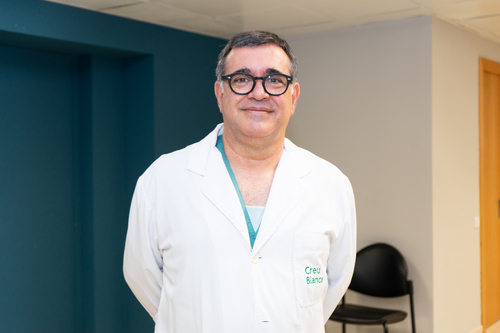Urinary symptoms are taboo for many patients, an example of this is urinary incontinence, an involuntary loss of urine that causes discomfort and affects the daily life of those who suffer from it. Despite being a very common disorder, most women prefer to hide it out of fear, shame or insecurity, which delays its diagnosis and treatment.
Sudden and urgent need to urinate, incontinence, or a feeling that your bladder does not empty completely?
The good news is that it can be treated. At the CreuBlanca Urology Unit we have extensive experience and a team of highly specialized professionals in the diagnosis and treatment of multiple pathologies that affect the lower urinary tract. One of the main tests to be performed is the urodynamic study or urodynamics. This is the first step to improve people’s quality of life.
What is urodynamics?
Urodynamics or urodynamic study is a simple test that in most cases is painless, lasts approximately 30 to 45 minutes.
It is performed with the aim of knowing the functioning of the sphincter, the urethra and the bladder, that is, how urine is stored and eliminated. This test is usually prescribed to patients with urination problems, to patients with urinary incontinence, or to patients with repeated urinary tract infections. We are aware of how embarrassing this type of exploration can be, which is why our team will accompany and guide you at all times in order to ensure your safety and well-being. Don’t be afraid of this exploration.
What is urodynamics?
It is important that you come calm and want to urinate, since during the examination we will reproduce the symptoms in order to find out the cause. But if the sensation is very annoying you can go to the W.C. We will make sure that you start the test properly. The test consists of several parts.
- First, the patient must urinate into a container called a flowmeter, which measures the amount and rate of urine.
- Then, with the help of a small probe, the remaining urine is emptied, which we call the “residue”.
- Next, another small-caliber probe is placed with which we fill the bladder and with electrodes we record the pressures that occur inside the bladder both during the filling and emptying phases.
- Finally, the patient must urinate with the catheter in place, which we will then remove, and in some cases we insert a last catheter to check the residue again.
- During the test we put all our effort to make this time as bearable as possible. At the end, the phrases we hear the most are: “if I find out, I won’t be so nervous” or “it hasn’t been that bad”.
The data recorded during the test allow to obtain an accurate diagnosis and to know the causes of multiple urinary disorders. All this in order to establish the best and most specific treatment for each patient.
Now that you know what a urodynamic study is and what it is for, we want to remind you that it is a very simple process and that, although it can be a bit annoying, it is not painful. At CreuBlanca we have a specialized and highly qualified team of urologists and nursing staff to carry out this test.

